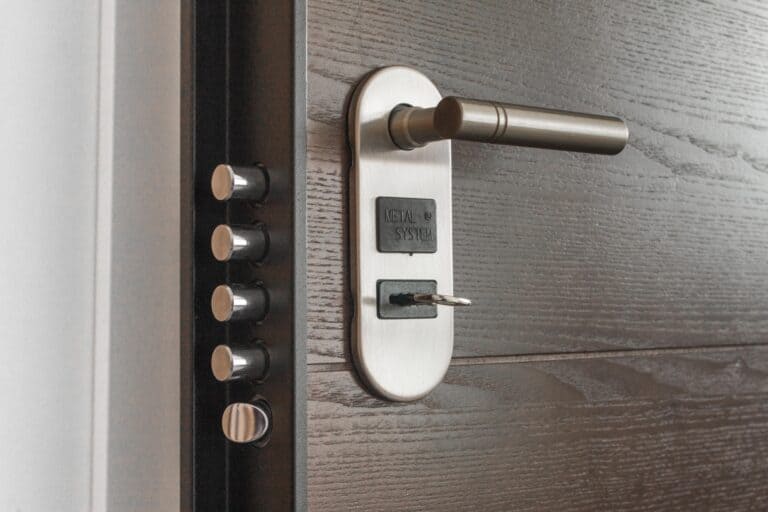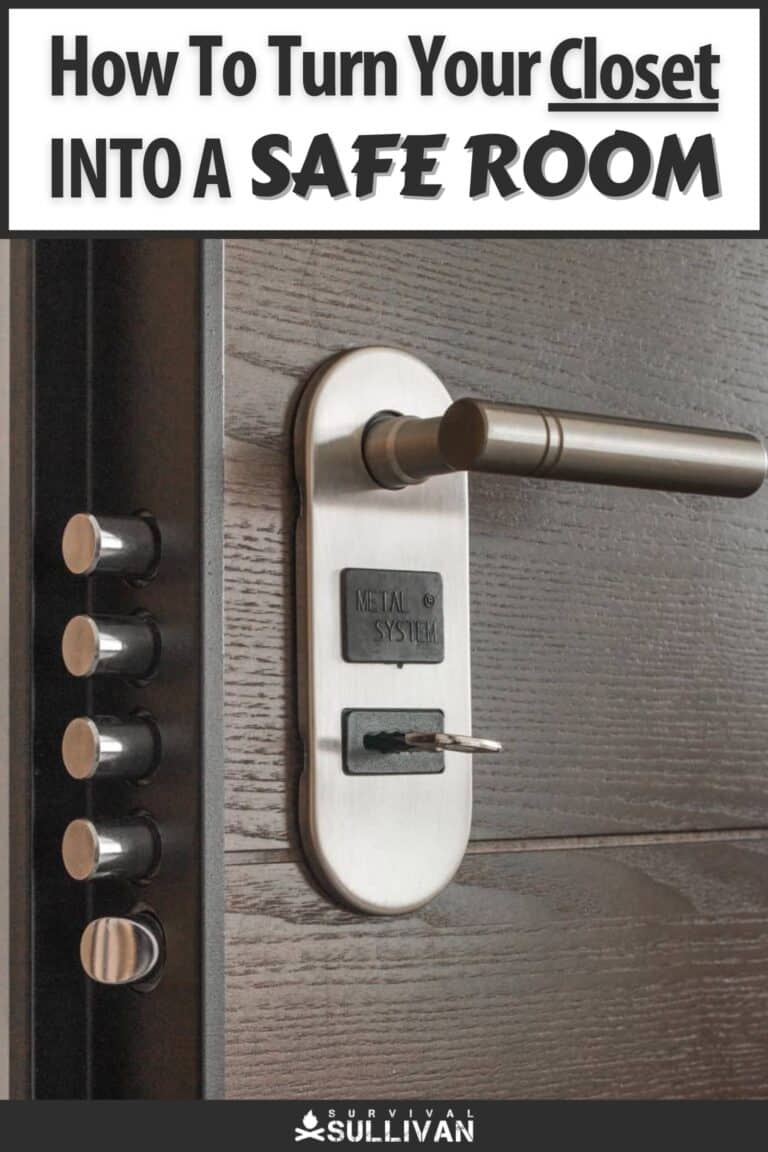[ad_1]
For many preppers concerned about beefing up their home security and overall preparedness, the safe room is something of an “apex prep” in their preparedness plan.

The idea of retreating to a hardened location that has everything you need to survive a disaster or bad guys breaking down your door is undeniably attractive.
Unfortunately, remodeling your house or crafting a bespoke edition to it in the form of a safe room is very expensive and beyond the reach of most of us.
But that doesn’t mean you have to give up on your dream of having a shelter inside your home: with some effort it is possible to turn a closet into a functional and effective safe room.
Keep reading, and I’ll tell you what you need to know if you want to undertake the project, what pitfalls to avoid, and what you must prepare for. Let’s get started.
What are You Preparing For?
The first thing you need to do before you undertake your closet safe room conversion is to get really clear on what you are preparing for.
Making a safe room that can withstand serious natural disasters like tornadoes or earthquakes is a bit different from crafting a safe room that can keep you and your family alive when armed and violent people storm into your house.
On that note, it is possible to do both. Generally speaking, any such room that will keep you safe from people must be able to withstand attempts to breach the safe room and also keep you and your family safe from gunfire.
A safe room that will keep you alive in the event of a natural disaster, specifically a wind or ground event, must withstand collapse and withstand the rest of the structure falling down on top of it.
Both use cases mandate that you have supplies inside the safe room that can keep you alive and reasonably comfortable while you wait for the cavalry to show up.
Consider the following factors for your closet-turned-safe room.
Reinforce the Walls and Ceiling
This is fundamental to creating it in the first place. Reinforced walls will better withstand stresses associated with natural disasters, resist crushing in the case of extreme load, and also give you some measure of protection against gunfire and attempts to breach into the room via a route besides the door.
Common drywall is no protection or barrier at all!
Of course, this is easier said than done: how exactly should you reinforce the walls? This depends very much on your home and your desired outcome, to say nothing of your budget.
It is possible to install a shelter module within the envelope of your home if you want tornado protection, as an example. You might also consider cement blocks, rebar-reinforced concrete, or even welded steel sheeting.
All of these materials have different associated costs, and are stronger or weaker against various threats.
Broadly speaking, if you want protection from gunfire, you’ll need concrete and lots of it or else steel if you aren’t going with specially designed fiberglass armor (which can be very expensive).
If want to make a safe room on the cheap, you could pile up sandbags or earthbags on the inside of the closet for protection from gunfire.
But, this won’t do much good in case of a natural disaster and will also eat up floor space inside the closet.
Reinforce the Floor, if Necessary
Before you even start reinforcing the walls properly, you’ll need to look at reinforcing the floor and, if the safe room is on a second floor, potentially structural walls below.
This is because adding all of this extra material, supplies, and more is going to put a considerable strain on the structure of your home.
Ask anyone who’s made the mistake of moving in a huge gun safe without having a structural analysis performed by an engineer or architect what happens!
This is something you cannot afford to get wrong, so unless your safe room-to-be is sitting directly on a slab, make sure you perform your due diligence and get the structure of your home inspected and verified against the scope of your project.
Omitting this critical step could have disastrous consequences.
Install a Hardened Door
One of the most important and, to many, most obvious components in a safe room of any kind is the door.
The door is what most of us see as the “shield” of the safe room, the barrier that is on the front line of keeping us safe, at least against human assailants.
And a door is indeed critically important in that very instance, but also important in case of a natural disaster because it forms another critical link in the protective envelope of the room.
For some folks, the obvious and only choice is a “safe” or vault-style door. These can definitely offer extraordinary protection against forced entry, and are certainly strong enough to resist the forces associated with natural disasters, but only if the surrounding frame and structure are as strong as the door.
You cannot buy the best door and omit upgraded walls, or else the walls will fail before the door does!
Another good and commonly overlooked option is a solid metal exterior-grade door, especially when it’s paired with equally high-grade hardware and an anti-kick device like a Door Devil.
A solution like this is usually far more affordable compared to a vault-style door above. These also maintain stylistic consistency with the rest of your home for a modest cost.
Make Sure You Have a Secondary Exit
One of the single most important elements of any safe room, and in my experience one of the most chronically neglected, is to ensure you have a secondary exit.
This is absolutely imperative to ensure that you and your family do not get trapped inside in the event of a structural collapse, or if the integrity of the safe room is about to be breached by intruders.
Or, most harrowingly, if the structure starts to burn down around you!
This could be something as simple as an inconspicuous concealed trap door leading into a neighboring room or out through the floor, or as intricate as a dedicated escape tunnel that will emerge somewhere else on your property.
Again, all things are viable if you have the budget, but the most important thing is that you have another way out.
Stock with Supplies
Your safe room should be stocked with survival and sustainment supplies based on the duration of the anticipated event.
Obviously, more supplies is always better, but in most closets, space is usually at a premium so this is something you’ll have to plan carefully.
If your safe room is intended to keep you safe and sound in case of natural disasters, you want to stock it with some basic food, water, medical supplies, and likely some spare clothing and basic tools like flashlights.
Against home intruders, first-aid supplies, weapons, pepper spray and the like is probably a worthwhile inclusion, along with things like body armor if you have it.
Remember that in some instances, such as a collapsed home in the aftermath of a tornado, you might be in for a very long wait until rescuers, relatives, or neighbors come looking for you and can dig you out. Try to prepare and stock your safe room accordingly.
Provide a Means of Communication
Installing or placing a means of communication with the outside world in your shelter is one of the smartest decisions you can make…
This can be something as simple as a spare cell phone with a SIM card that is kept on a charger, or as intricate as a dedicated handheld or ham radio setup complete with power supply.
The point is that you have something with which you can summon help even if your usual cell phone is misplaced, lost or broken.
Be sure that you have all important emergency contact numbers posted with your phone or radio, and then everyone in your family is familiar with its use.
Also, if you have security cameras around your home or other sensors, installing a redundant monitor or other device that can pick up the feed in your safe room is a brilliant idea.
Prepare for Sanitation Concerns
The last thing you need to consider when turning your closet into a safe room, and the least pleasant, is to provide for human sanitation.
It doesn’t matter what’s going on, when you got to go, you’ve got to go! And you are certainly going to make a bad situation exponentially more miserable if you don’t have a sanitary and preferably odor-free way to do your business.
Pretty much the only option here is a bucket toilet, with or without an accompanying seat.
Filling up a bucket with sawdust, kitty litter or composting toilet media and keeping a big pack of baby wipes handy along with a spare roll of mega-duty contractor bags can keep you and yours sanitary when nature calls.
Note that privacy is likely non-existent except in the biggest closets…
With a little luck, the situation will be over before you need to use it, but if that time comes you will be incredibly glad that you have it.
How Much Should You Expect to Spend on a Closet Safe Room Conversion?
The subject of cost always comes up in these discussions, and with good reason.
However, there is a very literally limitless amount of variety when it comes to your personal approach, options and desired outcomes when converting a closet into a safe room.
What’s most instructive, I think, is to give you a price range of consideration.
I’ve known quite a few folks that undertook this task, both as DIY’ers and resorting to hiring professionals, and I’ve seen what both budget and extravagant solutions look like.
A close friend of mine actually installed his own closet safe room by completely enclosing the entirety of the space himself with thick, hardwood posts, and then installing an aluminum sheathed reinforced frame for a metal door with anti-kick device like I recommended above.
He already had all of his supplies and gear, and doing every single bit of the labor himself he spent about $2,500.
On the extreme opposite end of the spectrum, I once consulted for a wealthy couple in Florida that was concerned about severe storms and also rising civil unrest.
As part of a “small” remodel, they had a small extension built around their existing house with a prefabricated, completely bulletproof safe room module.
It had the works: security camera monitors, food, water supply, air filtration, everything. State-of-the-art, and with a price tag to match at $500,000.
The point is to illustrate that, no matter what your position and financial resources, there is a way to improve your own home security by converting one of your closets into a safe room.

[ad_2]
Source link
Get more stuff like this
in your inbox
Don't Be Left Unprepared
Thank you for subscribing.
Something went wrong.




![Do you think food inflation will continue to rise? [Discussion] 8/1/22 Do you think food inflation will continue to rise? [Discussion] 8/1/22](https://i0.wp.com/theworldofsurvival.com/wp-content/uploads/2022/06/Two-is-One-and-One-is-None-The-Power.png?resize=370%2C297&ssl=1 370w, https://i0.wp.com/theworldofsurvival.com/wp-content/uploads/2022/06/Two-is-One-and-One-is-None-The-Power.png?zoom=2&resize=370%2C297&ssl=1 740w, https://i0.wp.com/theworldofsurvival.com/wp-content/uploads/2022/06/Two-is-One-and-One-is-None-The-Power.png?zoom=3&resize=370%2C297&ssl=1 1110w)
